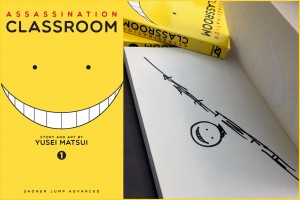Below is a web-friendly version of the CBLDF presentation on the history of comics censorship, which has been delivered to audiences of scholars, lawyers, advocates and readers in the United States. Please contact CBLDF about bringing this presentation to your group.
Challenged in Libraries!
Every year people try to take away readers’ power to decide what books are right for themselves or their children to read by bringing challenges to remove books from libraries. Although comics are growing in popularity every year, they are also among the most frequently challenged book categories. The Color of Earth, shown at left, was the #2 most challenged book of 2011.
Book banning is nothing new. Books are frequently banned for containing “adult content,” “language,” “sex/nudity,” or not being “age appropriate.” Comics are uniquely vulnerable to challenges because the medium thrives on the power of static images, and because there is a lingering stigma that comics are low-value speech. Some challenges are brought against comics because a single page or panel can be taken out of context, while others come under attack because of the mistaken notion that all comics are for children. Learn more about why comics are banned here.
Comics attacked include all-ages classics like Bone by Jeff Smith, Drama by Raina Telegemeir, as well as acclaimed books for adult readers including Alison Bechdel’s Fun Home, Neil Gaiman’s Sandman, Alan Moore’s League of Extraordinary Gentlemen, and others. Learn more about what comics have been banned or challenged here.
The CBLDF assists librarians by providing access to resources and writing letters of support in cases where comics are challenged. CBLDF has participated in helping challenges and stands ready to address new ones when they occur. CBLDF is also an active sponsor of Banned Books Week and the Kids Right To Read Project, initiatives that create tools and perform activities that advance the freedom to read.
Dragon Ball
 Akira Toriyama (VIZ Media, 2003)
Akira Toriyama (VIZ Media, 2003)
Dragon Ball follows the adventures of Goku and his friends from childhood through adolescence as he trains in martial arts. Goku embarks on a quest for the seven mystical orbs called Dragon Balls, which summon a wish-granting dragon when gathered. Inspired by traditional Chinese storytelling and myths, Dragon Ball is a modern take on timeless classics and embodies themes of friendship, rivalry, victory and loss. The graphic novels are the basis of the popular media franchise and subsequent spin-offs.
In 2009, the graphic novel series was challenged in Wicomico County, Maryland, because the books depict violence and contain incidental nudity. The review committee recommended that the books in the Dragon Ball series, which were listed by the publisher for ages 13+, be removed from the entire public school library system, including at the high school level. School officials acknowledged the value of graphic novels in their libraries and indicated that they would embark on “instituting more
focused and ongoing professional development training on the selection of media materials and additional procedures to handle student requests for media books and resources.”
Assassination Classroom
 Yusei Matsui (VIZ Media, 2014)
Yusei Matsui (VIZ Media, 2014)
In early 2019, Assassination Classroom was pulled from a school library on Staten Island over parental objections to its title and themes. The book’s removal runs contrary to New York City Department of Education guidelines. The manga is currently pending review by an evaluation committee and is unavailable to readers who may find insight and enjoyment in its pages. The series follows a group of misfit students, who pledge to stop an alien supervillain disguised as a teacher from destroying the world. The series uses comedy and superhero tropes to emphasize the values of camaraderie among students and the impact that good teaching can have in the lives of pupils others have discarded.
Sword Art Online: Aincrad
 Reki Kawahara and abec (Yen Press, 2017)
Reki Kawahara and abec (Yen Press, 2017)
CBLDF took the lead in defending the manga Sword Art Online: Aincrad after it was challenged at a middle school in Jerome, Idaho, where the book was ultimately retained. The first volume in a manga series by Reki Kawahara and illustrated by abec was challenged by a Jerome Middle School teacher on behalf of a student who found both language and drawings in the book to be “inappropriate.” The images that perturbed the student reportedly involved “a female character wearing underwear and sharing a bed with a male character.”
Readers Are Under Attack
A new generation of prosecutions against readers is emerging. Prosecutors, customs agents, and other law enforcement are targeting comics in print and online, most especially manga. In recent years CBLDF has aided an increase in cases involving readers wrongly accused of possession of obscene material and child pornography as a result of constitutionally protected comic book images in their possession.
This abrupt sea change in prosecution emerges from the passing of the PROTECT Act in 2003. PROTECT is a sweeping anti-child pornography law that expanded prosecutorial remedies to punish child sex offenses. Unfortunately, the law also created a new crime – producing, receiving, possessing or manufacturing “obscene child pornography” of a non-photographic nature.
Child pornography is photographic evidence of a crime where an actual minor is sexually abused. “Obscene child pornography” is a new category that criminalizes a non-photographic image, such as “a visual depiction of any kind, including a drawing, cartoon, sculpture, or painting” that depicts (i) a minor engaging in sexually explicit conduct and is obscene (§ 1466A(a)(1) and §1466A(b)(1)); or (ii) “an image that is, or appears to be, of a minor engaging in graphic bestiality, sadistic or masochistic abuse, or sexual intercourse and lacks serious literary, artistic, political, or scientific value (§ 1466A(a)(2) and § 1466A (b)(2)))
While much of PROTECT deals with protecting actual victims, the above provisions ban imaginative depictions in cartoons, paintings, sculpture and other art forms. The difficulty with these provisions is that they don’t protect victims of actual crimes, but instead criminalize speech. They also carry mandatory minimum sentences, which has led to at least one case where a guilty plea was forced in a case that could have prevailed.
Apart from being used to prosecute anime and manga, PROTECT has additionally contributed to a culture of misunderstanding about manga that has brought censorship and criminal charges against individuals outside the United States.
U.S. v. Whorley
U.S. v. Whorley was the first case to test manga within the confines of the PROTECT Act.
Dwight Whorley used computers at the Virginia Employment Commission, a public resource, to download manga alleged to depict “children engaged in explicit sexual conduct with adults.” He was charged with “knowingly receiving” child pornography for printing out two cartoons, and viewing others, 19 counts in all.
In 2006, a jury found Whorley guilty for “receiving” obscene cartoons, for which he was sentenced to 20 years in prison, with a 10-year probation thereafter. His sentence was aggravated by a previous conviction for receiving actual child pornography. If this were his first offense, he would have been subject to a minimum sentence of “not less than 5 years and not more than 20 years” in prison.
Whorley was sentenced under the same guidelines governing actual child pornography. CBLDF was not asked to assist in Whorley’s case. As policy, CBLDF does not aid in the defense of cases where real child pornography is in contention. However, we will provide substantive assistance in any case involving the prosecution of comic books, which are wrongly targeted in cases like Mr. Whorley’s.
U.S. v. Handley
Christopher Handley, a manga collector, was arrested in 2006 on possession of child pornography charges after postal inspectors viewed a package of manga he ordered from Japan. After receiving his package at the post office, he was followed to his home and served with a search by federal and local police who seized his lifetime collection of manga and anime – over 1,000 of books & magazines, hundreds of DVDs, and seven computers.
Handley was a model citizen with no criminal record. He was a computer programmer who served in the U.S. Navy, was disabled, and took care of his disabled mother in her home. His passions were manga and bible study. He possessed no photographic pornography of any kind.nnHandley was a collector of manga as a whole, and the vast majority of manga and images he possessed contained no fantasy representations of minors at all.
When Handley awaited trial, prosecutors did not distinguish between manga and obscene material. They prohibited him from viewing or accessing any manga or anime on the Internet, ordering anime video or written material, or engaging in Internet chat, the latter harming his ability to prepare his defense. Handley was also forced to undergo mental health counseling.
Unlike Whorley, who was convicted for mere possession of sexual images of minors, the court in Handley found that the images must be found obscene to be convicted.
Despite this one positive development, the government assumed an aggressive posture towards Handley, and ultimately he chose to plead guilty rather than face a mandatory minimum sentence of 5 years in prison.
Court documents show that Handley had no history of criminal behavior, possessed no actual photographic pornography of any kind, and posed no danger to anyone in his community.
Handley’s character is similar to so many in fandom. He began viewing anime and manga in college, beginning with material like “Record of Lodoss War.” With the rise of the internet, Handley was exposed to the vast diversity of manga, including, as the Defendant’s Sentencing Memorandum explains, “that subset of manga known as hentai, or sexually explicit manga. That interest led to the discovery of hentai manga featuring drawings of characters that appear as young girls, known as ‘lolicon.’” The Defense Memorandum adds, “the lolicon was only a minute portion of his entire collection, which consisted of tens of thousands of manga and anime, representing all genre of the art form.” The Defense describes Handley as “an introverted, 40-year-old virgin” who served in the U.S. Navy and went on to achieve a successful career as a computer programmer following his medical discharge. Handley lives with his mother, whom he assists due to numerous medical problems. His chief social outlets were work and a Bible Fellowship group. The Defense Memorandum explains, “Other than his Bible study group, Mr. Handley spent most of his free time at that house, either with his mother, or alone in the basement, playing online fantasy games such as Everquest 2, and reading comic books.”
In sentencing documents, the government argued that the mere possession of graphic manga represented a form of “sexual deviancy” that required imprisonment to be followed by psychological treatment and supervision. Handley’s conviction represents a shameful illustration of the United States government prosecuting an individual for the content of art in his private possession, and for the thoughts he may have had while viewing that art. It’s not alarmist to suggest that Handley’s case represents an illustration of the United States prosecuting thought crimes.
Handley was not represented by the Comic Book Legal Defense Fund, though the Fund was approached after the case was underway to provide expert witnesses for the defense. Unfortunately, Handley entered a guilty plea under the advice of his counsel before the case saw trial. The CBLDF had previously expressed disappointment with the decision not to fight the indictment.
Handley was sentenced to 6 months in prison to be followed by three years of supervised release running concurrent with five years of probation, and forfeiture of all material seized by police.
Handley was ultimately convicted for receiving and possessing obscene cartoons for possessing seven (7) books:
- Mikansei Seifuku Shōjo (Unfinished School Girl) by Yuki Tamachi (LE Comics)
- I [Heart] Doll by Makafusigi (Seraphim Comics)
- Kemono for ESSENTIAL 3 (THE ANIMAL SEX ANTHOLOGY Vol.3) by Masato Tsukimori et al (Izumi Comics)
- Otonari Kazoku (Neighboring House Family) by Nekogen (MD Comics)
- Eromon by Makafusigi (Seraphim Comics)
- Kono Man_ ga Sugoi! (This Man_ is Awesome!) by Makafusigi (Seraphim Comics)
- Hina Meikyū (Doll Labyrinth) by Makafusigi (Seraphim Comics)
R. v. Matheson
In 2010, Ryan Matheson a 25 year old American citizen, computer programmer, and manga fan was unlawfully arrested & abused by Canadian authorities. He was wrongfully accused of possessing and importing child pornography because of constitutionally protected manga on his laptop – before he was let into the country!
Ryan suffered severe abuse by the authorities. He wasn’t properly informed of the reason for detention. He was denied access to counsel & the American Embassy. The search of his property was illegal. He suffered cruel & unusual punishment, including being denied food and blankets. Police transporting him to prison actually said “if you get raped in here, it doesn’t count!”
Like Handley, Ryan had no criminal record, and was not in possession of any photographic material.
Ryan was released to await trial, but one of the conditions was that he was not allowed to use the Internet outside of work at one specific company. For two years his life was frozen under this false accusation.
The material Ryan was accused of possessing was innocuous. One image, below, “The 48 Positions: Moe Style” is a parody of two famous images. The other was a common doujinshi, or fan-made comic book, depicting a fantasy scenario between non-human characters.
CBLDF aided Ryan’s defense, which included expert testimony about the artistic merit of manga; the fact that the material he is accused of possessing is protected speech in his home country of the US; and that the material is accepted in its origin country of Japan.
As a result of Ryan’s strong defense, the Canadian government dropped all charges against Ryan earlier this year.
In addition to substantive aid, CBLDF assisted Ryan’s case financially. Ryan’s total legal fees totaled $75,000. CBLDF has contributed $30,000 to those expenses to date, and our colleagues at Canada’s Comic Legends Legal Defense Fund contributed $11,000. We are currently fundraising to restore the final $34,000 Ryan was forced to spend defending himself against these outrageous charges. To help us, please make a donation.
